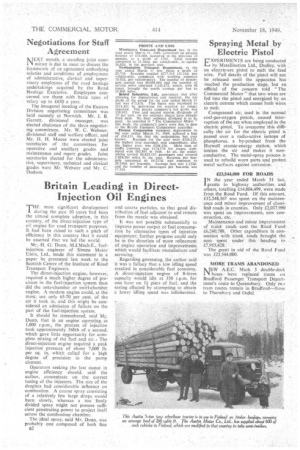Britain Leading in DirectInjection Oil Engines T HE most significant development
Page 36

If you've noticed an error in this article please click here to report it so we can fix it.
during the past 10 years had been the almost complete adoption, in this country, of the direct-injection type of oil engine for road transport purposes. It had been raised to such a pitch of efficiency in this country that it could be asserted that we led the world.
Mr. H. G. Dunn, M.I.Mech.E., fuelinjection engineer of Simms Motor Units, Ltd., made this statement in a paper he presented last week to the Scottish Centre of the Institute of Road Transport Engineers.
The direct-injection engine, however, required a much higher degree of precision in the fuel-injection system than did the ante-chamber or swirl-chamber engine. A modern engine could, at the most, use only 65-70 per cent. of the air it took in. and this might be considered an admission of failure on the part of the fuel-injection system.
It should be remembered, said Mr. Dunn, that in an engine operating. at 1,800 r.p.m., the process of injection took approximately 360th of a second, which gave little opportunity for complete mixing of the fuel and air.. The direct-injection engine required a peak injection pressure of about 7,000 lb. per sq. in, which called for a high degree of precision in the pump element.
Operators seeking .the last ounce in engine efficiency should, said the author, concentrate on the correct tuning of the injectors. The size of the droplets had considerable influence on combustion. A coarse spray consisting of a relatively few large drops would burn slowly, whereas a too finely divided spray might not possess sufficient penetrating power to project itself across the combustion chamber.
The ideal spray. said Mr. Dunn, was probably one composed of both fine B2
and coarse particles, so, that good distribution of fuel adjacent' to and remote from the nozzle was obtained.
It was not possible substantially to improve power outtatt or fuel consumption by alternative types of injection equipment; further progress could only be in the direction of more refinement , of engine operation and improvements which would facilitate manufacture and' servicing.
Regarding governing, the author said it was a fallacy that a low idling speed resulted in considerable fuel economy. A direct-injection engine of 8-litres capacity would idle at 350 r.p.m. for one hour on 1. pints of fuel, and the saving effected by attempting to obtain a lower idling speed was infinitesimal.




























































































